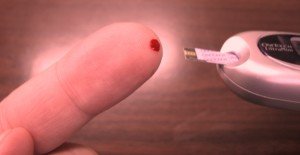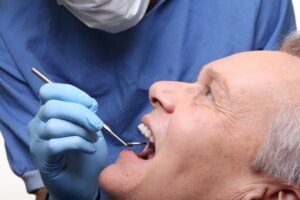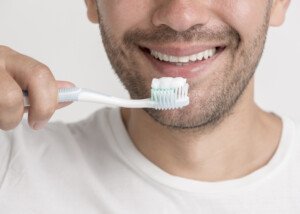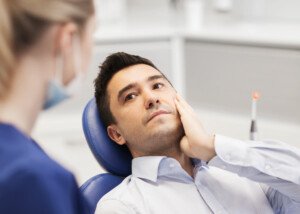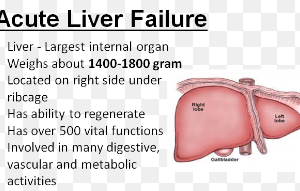Exercises You Should Avoid if You Have Diabetes
You have diabetes and want to exercise, but are wondering what kind of exercises are off-limits for your condition – whether you’re type 2 or type 1. (more…)
Why Can’t People with Severe Dementia Have Bypass Surgery?
If the arteries of someone with dementia beyond early stage are so blocked that coronary bypass surgery is the only hope, they’ll be denied this surgery. (more…)
Painless Hard Lump on Gum? Can Cause Include Cancer?
If you’ve found a painless hard lump on a gum, it’s not likely to be cancer, but a tumor needs to be ruled out – especially if you can’t tell if the lump is truly hard or is somewhat soft.
Your mouth will often get a number of sores and other events, and most of them are not going to amount to anything.
Many of them will usually heal and often disappear rather quickly.
One such feature that is permanent is a bony growth that often occurs on the gums – usually on the tongue side of your teeth on the lower jaw, under your tongue or on the roof of your mouth.
This painless growth is called a dental tori or torus mandibularis.
About Dental Tori
Dental tori will be pink colored – the same color as the inside of your mouth. They often grow bilaterally, growing on both sides of your mouth at the same time, and are harmless.
This bone growth, which may appear as a single, painless hard lump or as several, are generally covered by the same tissue that lines your mouth, and it’s smooth.
They really are not unusual and mostly do not require any treatment. About 27 out of 1,000 people or about five percent of the population will develop dental tori.
Oral Cancer
The lump that you’re seeing on your gum is not likely going to be oral cancer. Although a lump is often one of the first signs of mouth cancer, those lumps are almost always soft.
Because a tori in the mouth (tori means bone growth) is always hard, a hard lump is unlikely to be cancerous.
Causes of Torus Mandibularis
Dental tori can occur at any stage of life, but it more commonly starts in young adults.
Several factors can influence the development of tori, including genetics and the stress placed on the jawbone (clenching of teeth and teeth grinding).
Males have a slightly higher risk of developing them than females
Removal of Dental Tori
In most cases, it’s not necessary to remove the tori. It only becomes necessary when it starts to interfere with your eating or talking.
They will continue to grow but at different rates at different times of your life. Another occasion that may require removal of the tori is when you’re being fitted for dentures.
When to See the Dentist
Dental tori will produce a hard lump, but if you have a sore that does not disappear after two weeks, or if you have other suspicious sores or developments, see a dentist quickly for a diagnosis.
Keep in mind that if a dentist suspects cancer, you will be urged to see your primary care physician who can then get the ball rolling for diagnostics.

Dr. Vadivel, DDS, is a board certified periodontal surgeon, and Founder-CEO of Implants & Gumcare of Texas, offering affordable restorative and cosmetic dental procedures. Dr. Vadivel has over 25 years of experience.
.
Top image: Shutterstock/Djomas
Cause of Swollen Gums Around a Wisdom Tooth: Never Ignore

Swollen infected gums around a wisdom tooth require immediate treatment to prevent a very serious spread of the infection that can become fatal.
Swollen gums and inflammation around a wisdom tooth is a situation you cannot ignore.
It indicates an infection and it could become very serious. This condition is called pericoronitis.
Watching for other symptoms that accompany it is important, and it needs to be diagnosed quickly by your dentist.
The Cause of Swollen Gums
Pericoronitis is caused when a wisdom tooth is only partially sticking out of the gums. It does not fully erupt.
This enables food particles and bacteria to enter the gums next to the tooth and get trapped there, causing inflamed gums.
As the area at the back of your mouth is not easy to clean, and also because of the flap, the infection can become serious.
In fact, it could become fatal if it spreads very far. In severe cases, the inflammation keeps spreading and can extend into your cheeks and neck.
Symptoms of a Spreading Gum Infection
The symptoms you want to watch for indicate that the infection is expanding and has started to reach a dangerous level.
If left alone, it can become life threatening. The symptoms are fever, an earache, and you will have difficulty breathing.
The infection can be rather painful. You may also taste pus and have bad breath.
If there is a tooth above that wisdom tooth, it will likely be painful when you bite down due to the inflammation.
In addition to difficulty breathing, some other symptoms to be on the alert are: muscle spasms in your jaw, swollen lymph nodes under the jaw, or a swollen area of your face.
This condition can also lead to gum disease. Once it gets started and becomes periodontitis, it can affect your gums and teeth.
The inflammation spreads and your immune system reaction starts to destroy your gums, the ligaments that support your teeth, and your jawbone.
Diagnosis and Treatment
The dentist will need to look at and diagnose the condition.
With pericoronitis, the dentist will need to drain the pus and clean the area.
Antibiotics will need to be given, and saltwater rinses will need to be taken for several days.
It is also possible that you will need wisdom teeth removal.
When to See the Dentist
If you have swollen gums around a wisdom tooth, it’s important to seek dental care right away, which may include a wisdom tooth extraction.
Besides being painful, it may lead to a life threatening infectious spread.

Dr. Vadivel, DDS, is a board certified periodontal surgeon, and Founder-CEO of Implants & Gumcare of Texas, offering affordable restorative and cosmetic dental procedures. Dr. Vadivel has over 25 years of experience.
.
Top image: Shutterstock/sheff
Can a Bad Fitting Crown Infect the Gums?
There are reasons why a crown can become bad fitting and possibly cause a gum infection.
Dental crowns are used to restore the health and appearance of a damaged tooth.
This means that they need to go down to the gum line to create a uniform appearance.
Dental crowns, which can give the tooth a new look and life, can also result in pain.
This may occur shortly after the placing of a new crown or it may occur much later. If a crown does not fit well, it may infect the gums.
A Bad Fitting Crown
When the crown was put on, the nerve in the tooth may have been traumatized, which can cause it to die later.
This could be the result of putting in a post to help securely attach it to the remaining parts of the tooth.
In some cases, placing the post may lead to an infection in the gums, and a root canal will be needed.
A Cavity
While most people believe that a crown should mean that there will be no cavities in that tooth, that simply is not true.
Cavities may still develop under the crown or at the edge of it, where it meets the gums.
This can cause an infection in the tooth which may spread to the gums. This condition may lead to an abscessed tooth, which needs immediate attention from a dentist.
A Root Canal
When a tooth crown is going to be put in place, a dentist will often perform a root canal. This is not always done if the roots of the tooth are in good condition.
Later on, bacteria may cause an infection in the tooth. Removing the infection will require a root canal.
If the tooth has already had a root canal, it’s possible that it can become infected again.
This can occur for two reasons: Either the sterilization was not as thorough as it should have been and some bacteria remained, or it could be because bacteria entered in through spaces between the ill-fitting crown and the tooth.
Treatment
If an infection occurs in the tooth beneath a crown, the dentist may attempt to treat it by drilling a small hole in the crown to access and address the infection.
This method allows for direct treatment of the affected tooth, often through root canal therapy.
However, if the infection is extensive or the crown is compromised, the dentist might need to remove the crown entirely.
In such cases, the tooth will be treated, and a new crown will be fitted once the infection is resolved and the tooth is restored.
When to See the Dentist
If you have symptoms of an infection in a tooth that has a crown, you should seek treatment right away.

Dr. Vadivel, DDS, is a board certified periodontal surgeon, and Founder-CEO of Implants & Gumcare of Texas, offering affordable restorative and cosmetic dental procedures. Dr. Vadivel has over 25 years of experience.
.
Top image: Shutterstock/Syda Productions
Why Aren’t CT Heart Scans Done in Emergency Rooms for Chest Pain ?
If you go to the ER for chest pain, you won’t be given a CT scan of your heart just because of your symptom.
And if you do get one, it won’t be to check for a heart attack as the cause of the chest pain.
“There are two types of CT angiogram that could be performed in the ER for chest pain — CT pulmonary angiogram and CT coronary angiogram,” says Resham Mendi, MD, a renowned expert in the field of medical imaging, and the medical director of Bright Light Medical Imaging.
“A CT pulmonary angiogram would be done if the doctor thinks that there is a risk for pulmonary embolism (blood clot in the pulmonary artery). This is frequently done in emergency rooms.”
The doctor may refer to the procedure as just a “CT scan” when speaking to the patient or family member.
However, it requires an injected contrast dye to show the blood vessels.
A kidney test is done to make sure the patient’s kidneys are healthy enough to tolerate the contrast dye.
This imaging study will look at the lungs, not the heart.
A complaint of chest pain will net a blood test called D-dimer which can indicate the presence of a blood clot somewhere in the body.
This is why the pulmonary angiogram is ordered, because a blood clot in the lung can cause chest pain.
D-Dimer Is Negative, so Why Not a CT Angiogram for the Chest Pain?
“A CT coronary angiogram is done to look for blockage in the coronary arteries which could cause a heart attack,” says Dr. Mendi.
“This is not typically done in the ER because of the urgent nature of heart attacks.
“If there is concern for heart attack, they usually do EKG and blood tests in the ER as a quick way to look for abnormalities.
“If more evaluation is needed, they would rather do a traditional coronary [catheter] angiogram rather than a CT coronary angiogram.
“This is because during a traditional coronary angiogram, if the cardiologist sees a blockage, they can open it up right away while they are looking at it. This cannot be done in a CT coronary angiogram.”
The traditional or catheter angiogram carries a risk of stroke and heart attack, though these complications are rare.
Nevertheless, due to these risks, this gold-standard procedure is reserved for patients whom doctors are pretty convinced have serious blockages.
If the blockage can be treated with a stent, the stent placement can be done right on the spot during the catheter procedure.
The doctor may also determine that bypass surgery is the only viable treatment. The patient may then be prepped on the spot for emergent surgery.
You can now see how a CT angiogram would be an extra, burdensome step that would potentially delay things – which is why currently, it’s not a routine procedure in the ER to evaluate chest pain – especially in patients at low risk for coronary artery disease.
 Dr. Mendi has published several articles in radiology journals and has expertise in MRI, women’s imaging, musculoskeletal, neurological and body imaging.
Dr. Mendi has published several articles in radiology journals and has expertise in MRI, women’s imaging, musculoskeletal, neurological and body imaging.
 Lorra Garrick has been covering medical, fitness and cybersecurity topics for many years, having written thousands of articles for print magazines and websites, including as a ghostwriter. She’s also a former ACE-certified personal trainer.
Lorra Garrick has been covering medical, fitness and cybersecurity topics for many years, having written thousands of articles for print magazines and websites, including as a ghostwriter. She’s also a former ACE-certified personal trainer.
Fruit Eating Guidelines for Diabetics
The sugar in fruit can add up fast, so just how much fruit can people with diabetes eat at one sitting and also in one day?
Diabetics should not give up fruit just because it contains sugar. (more…)
How Does a Dentist Screen for Oral Cancer?
There are several types of cancer that can occur in the oral cavity and all of them pose a serious risk. (more…)
Why Don’t All People with Cardiorenal Syndrome Get Drug Treatment?
What contraindicates drug treatment in cardiorenal syndrome if the only drugs that can reverse the condition—or at least—extend survival, might cause further kidney injury? (more…)
How Much GERD Causes Barrett’s Esophagus?
How much acid reflux must you have in order to cause Barrett’s esophagus, a precancerous condition in the “food pipe” that’s a risk factor for esophageal cancer?
If a person suffers from acid reflux symptoms every day, is this enough to cause Barrett’s esophagus after a certain length of time?
Is it a type of symptom that’s more relevant to the development of Barrett’s, such as heartburn as opposed to coughing?
Does the severity of the GERD symptoms play into this?
In short, should people have anxiety over developing Barrett’s esophagus just because they have GERD or episodes of acid reflux?
Symptoms of Acid Reflux
• A burning or aching in the chest and/or upper abdomen
• Coughing, which may be present only overnight
• Waking with an odd taste in the mouth. The taste may also be triggered by exercise like running, step aerobics or jumping.
• A burning or lump feeling in the throat
• Sensation of difficulty swallowing
“We know that Barrett’s esophagus is due to chronic exposure of the esophagus to acid and stomach contents,” says Alan Gingold, DO, a board certified gastroenterologist with Central Jersey Ambulatory Surgical Center.
“Typically, five years or more of reflux is considered the minimal amount of time that it takes for patients to develop Barrett’s in the setting of chronic reflux.
“Obviously this is an average, and so there are patients who have less than five years’ exposure and develop Barrett’s, and there are patients with many more than five years and never develop Barrett’s.
“Risk factors for Barrett’s include cigarette smoking and other factors such as being a white male, obesity, alcohol use, FH adenocarcinoma of the esophagus.”
There is no research that links a subjective report of severity of a GERD symptom with the likelihood of developing Barrett’s.
For instance, nobody can say that a subjective report of chest pain being “severe” puts the patient at greater risk of Barrett’s than someone who reports their acid reflux chest pain as only “mild.”
Reflux symptoms occurring often throughout the day, has also not been linked to a higher risk of Barrett’s than does having the symptoms only occasionally throughout the day.
Finally, type of symptom has not been found to be linked to any higher risk.
Thus, the person whose GERD causes mostly throat related symptoms is not more or less likely to get Barrett’s than someone whose acid reflux only causes chest or abdominal discomfort, or whose reflux occurs only after eating, or only overnight, or only during anxiety or exercise, etc.
If you’re worried about developing Barrett’s esophagus, then take measures to lower your risk for this precancerous condition:
• Stop smoking
• Avoid drinking
• Lose excess body fat
• Eat fewer processed foods and more fruits and vegetables.
• Replace white flour foods with whole grain versions.
• Replace white rice with brown rice.
If your acid reflux or GERD symptoms are not responding to medication or conservative treatment (e.g., sleeping with torso elevated), or if they are longstanding — see your doctor.


